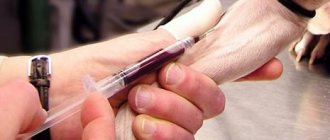Norm of analysis
To find out the number of leukocytes in an animal, you need to take a routine clinical blood test.
Veterinarians often prescribe such a study when diagnosing various diseases or during a preventive examination. White blood cell levels can tell a lot about your pet's health. The norm for cats is considered to be a leukocyte content from 5.5x103/l to 18x103/l. If the number of white blood cells is below acceptable values, then veterinarians call this condition leukopenia.
Clinical manifestations
What are the symptoms of leukopenia in cats? Everything is quite simple here. Firstly, the animal is constantly sick. He is plagued by digestive disorders, and the cat constantly “catch” diseases of the upper respiratory tract. In severe cases, it can lead to chronic bronchitis and even pneumonia. Deterioration of the condition of the skin and coat, as well as inflammation of the gums and other periodontal diseases are often recorded.
In addition, you can notice swollen and inflamed lymph nodes, the animal quickly gets tired, it is lethargic and apathetic. There is no appetite, the cat may experience constant cases of conjunctivitis, bloody diarrhea, vomiting... In short, the symptoms correspond to serious diseases of an infectious and inflammatory nature.
How to identify the disease
A low level of leukocytes in a cat’s blood can only be detected by the results of clinical tests. And it is advisable to identify any disease as early as possible - often the success of treatment depends on this. Therefore, it is very important to know what signs can be used to detect a decrease in leukocytes. Let's list the main symptoms :
- The animal often suffers from colds. In the most advanced cases, a cat can even catch pneumonia and chronic bronchitis.
- Indigestion that does not stop for a week or more even with a change in food.
- Inflammation of the gums - the cat refuses to eat because it hurts to eat.
- Deterioration of the condition of the coat and skin.
In the most advanced cases, conjunctivitis and bloody vomiting may appear. But this happens relatively rarely.
So, if you notice such signs in your pet, you should visit your veterinarian as soon as possible and get a referral for a complete blood count. The indicators obtained from the formula will allow you to more accurately determine the condition and, accordingly, make a more accurate diagnosis.
Causes of leukopenia
Why can a cat's white blood cells be low? The reasons for such a deviation may be the following:
- Stressful situations. If the animal was frightened on the eve of the study, this may lead to a temporary drop in leukocytes. This is not a dangerous phenomenon. Usually, after the cat calms down, all blood counts return to normal. Prolonged stress can lead to persistent leukopenia. In this case, you need to pay attention to the pet’s lifestyle.
- Avitaminosis. White cell levels may drop if the animal is not fed properly. With a deficiency of B vitamins in food, a decrease in leukocytes gradually develops. However, this situation can be easily corrected. To do this, it is enough to review your cat’s diet and include foods rich in vitamins or special supplements.
- Taking hormonal medications. For arthritis and other joint diseases, cats are prescribed corticosteroids. These drugs quickly relieve pain and inflammation, but at the same time reduce white blood cells. After completing the course of treatment, blood test results return to normal.
In these cases, the leukocytes in the cat’s blood are slightly reduced. This deviation is temporary.
However, leukopenia can also be associated with serious pathologies that require immediate treatment. This may be a sign of the following diseases:
- Bacterial infections. Of these diseases, sepsis is the most dangerous. With this pathology, pathogenic microorganisms constantly circulate in the bloodstream. Panleukopenia (distemper) is also a dangerous infection. With this disease, the level of leukocytes is sharply reduced, as these blood cells are rapidly destroyed.
- Chronic inflammation. Leukocytes rush to the pathological focus and leave the blood.
- Pancreatitis. Inflammation of the pancreas is often accompanied by leukopenia.
- Bone marrow diseases. This is the most dangerous cause of leukopenia. Diseases of the hematopoietic organs are difficult to treat and often result in the death of the pet.
We suggest you read How to protect furniture from cat claws.
How to stop a cat from tearing up furniture and more? We teach good behavior. How to stop a cat from tearing furniture and wallpaper In any case, low leukocytes in a cat require attention. If this condition is caused by temporary and random reasons, then it is enough to change the animal’s lifestyle and diet. If leukopenia is associated with pathology, then additional examination and treatment by a veterinarian is necessary.
Predisposing factors
Viral infections are the most common cause of leukopenia in cats. Feline immunodeficiency virus (FIV) and feline infectious peritonitis (FIP) are the most dangerous in this regard. Their peculiarity is that infectious agents can penetrate into the leukocytes themselves, where they successfully reproduce and destroy protective cells.
Of course, the number of the latter is sharply decreasing. Other causes of leukopenia may include:
- Bacterial infections. Moreover, this cause refers to almost everything: from abscesses to sepsis.
- Any inflammation causes a decrease in the number of leukocytes (and neutrophils in particular) if it has become chronic.
- All types of bone marrow diseases, including severe injuries, poisoning, exposure to radioactive materials.
- Pancreatitis. Inflammation of the pancreas will “pull” white blood cells from the bloodstream, which over time will lead to leukopenia.
- Certain medications. Corticosteroids, used to treat arthritis and other inflammatory pathologies, suppress the production of white blood cells when used long-term. As a rule, the pathology in this case is reversible.
- Stress. Long-term stress leads to many negative consequences for the body, including disruption of the bone marrow.
Main forms of lymphoma
Intestinal lymphoma
This term describes lymphoma that affects the gastrointestinal tract. By far the most common type of lymphoma in cats. Occurs in more than half of cases of the disease. More often diagnosed in cats aged 9-13 years
Symptoms
- loss of appetite
- weight loss
- vomit
- diarrhea
The gastrointestinal form, when treated at an early stage, leads to remission. Unfortunately, lymphoma is never completely cured; remission is possible, a temporary condition when the cancer stops and all signs of lymphoma disappear. The average remission of low-grade lymphoma is 2-3 years.
At an advanced stage, lymphoma is more difficult to treat, with only 25-50% of cats achieving remission with treatment. This period lasts only 2-9 months, after which the disease reappears.
Mediastinal lymphoma
This form of lymphoma affects the lymphoid organs in the breast, such as the lymph nodes. Mediastinal lymphoma is often seen in young cats with an average age of 5 years. This type of disease is closely related to the feline leukemia virus, with 80% of affected cats testing positive for leukemia.
Symptoms
- labored breathing
- pulmonary edema
- signs of heart failure
- swollen lymph nodes
Mediastinal lymphoma in cats with leukemia has a poor prognosis, with a median survival of only 3 months. Cats without leukemia have an average survival time of 9-12 months.
Renal lymphoma
Lymphoma in the kidneys can lead to signs of kidney failure as functional kidney cells are replaced by cancer cells. This type of lymphoma is also associated with feline leukemia, with half of affected animals testing positive for leukemia.
Symptoms
- loss of appetite
- apathy
- polydipsia
- polyuria
Renal lymphoma is the most difficult form, the average survival rate for this type of disease is only 3-4 months, but there are cases where cats survive much longer. Renal lymphoma tends to spread to the brain and central nervous system; this occurs in approximately 40% of cases of renal lymphoma and worsens the prognosis of this disease.
Sign up for a lymphoma diagnosis
Types of leukocytes
If the analysis reveals that the cat’s leukocytes are low, the doctor will prescribe an additional examination. It is called a leukogram. This test helps identify which type of white cells are elevated.
The following types of leukocytes exist:
- lymphocytes;
- neutrophils;
- eosinophils;
- basophils;
- monocytes.
Let's take a closer look at the possible reasons for the decrease in each of these types of blood cells:
- Lymphocytes are cells that recognize and reject foreign agents. This type of leukocytes can be reduced in chronic diseases of the liver, kidneys and lungs, immunodeficiency states, as well as during treatment with steroid hormones.
- Neutrophils destroy foreign proteins. A decrease in the number of these cells is observed in bacterial and fungal pathologies, anemia and bone marrow diseases. The cause of leukopenia in this case may also be the use of antifungal drugs or radiation therapy.
- Eosinophils fight allergens. A decrease in this type of cells is observed during acute infections, injuries, burns, and also after myocardial infarction. Eosinophilia is also seen in older cats.
- Basophils are rarely detected in the blood of cats. Their presence in the analysis usually indicates an allergy. Therefore, a decrease in basophils or their absence is not a sign of pathology.
- Monocytes reject dying cells and foreign proteins. A decrease in these blood elements can be observed with sepsis, bone marrow damage, as well as after childbirth and during treatment with corticosteroids.
We suggest you read: Is it possible to become infected with worms from a cat to a person and how are helminths transmitted?
How leukocytes can change and the reasons for this phenomenon
An increase in white blood cells is usually accompanied by inflammatory reactions and an infectious process. In this case, young cellular forms predominate. A decrease in the number of leukocytes can be associated with the use of a number of medications, radiation exposure, and shock. In some infections, the white blood cell count may be low. Moreover, various types of pathologies are characterized by changes in one form or another of leukocytes.
Lymphocytes
These formed elements take an active part in the recognition and rejection of foreign proteins. They also participate in the processes of humoral immunity and are cytotoxic to cancer cells and cells affected by viruses.
An increase in the level of lymphocytes (lymphocytosis) signals lymphocytic leukemia or the penetration of toxoplasma into the animal’s body, or a number of viral infections.
A decrease in the level of these elements (leukopenia) is observed in immunodeficiency states, liver pathology and kidney disease, with long-term therapy with corticosteroids, circulatory failure and chronic pulmonary pathology.
Neutrophils
The main purpose of these formed elements is to destroy pathogens, foreign particles and proteins that have entered the animal’s body.
Exceeding the norm of these elements (neutrophilia) indicates an infectious process in the cat’s body, poisoning, cancer, or long-term use of antihistamines or steroid drugs.
A decrease in the number of neutrophils (neutropenia) indicates bone marrow pathology and impaired immunity, some bacterial and fungal infections, and some types of anemia. A decrease in these elements is observed with long-term use of certain antimycotic drugs and radiation therapy.
A neutrophilic shift to the left (the appearance of a larger number of band elements) indicates a decrease in the overall reactivity of the animal’s body. A right shift in the leukogram (a decrease in the number of band elements and an increase in the number of segments) may be evidence of certain types of anemia, kidney pathology and liver disease.
Eosinophils
They have phagocytic activity, but this quality is demonstrated mainly when participating in an allergic reaction. They absorb and digest the antigen + antibody complex formed by immunoglobulin E.
Eosinophilia or an increase in the number of these elements is observed in bronchial asthma, various types of allergic reactions, helminthiasis, in infectious diseases at the recovery stage, and long-term antibiotic therapy.
Eosinopenia or a decrease in the number of eosinophils in the blood is detected in acute infections, burns, injuries, stressful situations, in elderly animals, on the 1st day after a heart attack, in the early postoperative period.
Basophils
They are directly involved in the inflammatory and allergic reactions of the cat’s body.
Basophils are found in the blood of an animal during allergic reactions, leukemia, ulcerative processes or chronic inflammation in the intestines, acute inflammation of the liver, and endocrine disorders.
Monocytes
These elements are classified as agranulocytes; they have phagocytic properties and are designed to rid the cat’s body of dying cells, denatured protein, pathogens (bacteria) and antigen+antibody complexes.
Monocytosis occurs in acute infectious diseases, including protozoans, oncology, leukemia, and in the early postoperative period.
Monocytopenia can be diagnosed during sepsis, during childbirth, bone marrow damage, and long-term therapy with hormonal drugs.
As with human diseases, among our smaller brothers a blood test is important for diagnosing diseases
The doctor's attention is drawn to all indicators, especially the number of lymphocytes. This is one of the subspecies of white blood cells that, unlike their relatives, are capable of acting repeatedly and not dying after the first attack
Lymphocytes provide specific immunity by identifying foreign antigens and producing an adequate response - antibodies that can selectively destroy foreign “intruders”. They are indicators of the functioning of the animal’s immune system, so they immediately make it possible to suspect the presence of a particular disease.
How is this treated?
What is the treatment for leukopenia in cats? Here everything depends on the root cause that caused the decrease in the number of leukocytes in the blood. Antibiotics, antiviral drugs, polyvalent serums are prescribed, operations are performed to excise foci of purulent inflammation, etc.
Unfortunately, bone marrow diseases are incurable, and your pet's life expectancy will depend only on care and supportive therapy. In severe cases, one even has to resort to regular blood transfusions, but in our conditions, for obvious reasons, this is not practiced. If the cat manages to “catch” a disease that is contagious to humans, euthanasia is recommended.
What you need to know about white blood cell levels in cats
Let's start with the fact that the normal number of leukocytes is 5.5-18.0 * 109/l. It is ideal if the level remains in this range. Unfortunately, with various diseases it can change significantly. For example, if the white blood cell count is elevated, this is an alarming sign - most likely there is some kind of inflammation in the body. But there is no need to worry right away. The cause may well be a mild cold.
© shutterstock
It is much worse if the level is significantly below normal. Then the diagnosis is simple - leukopenia. And this is already very bad. Often this disease is a consequence of sepsis - a serious reaction of the body to an invading infection .
In this case, even the best medicines and high-quality treatment may not save the cat. However, there is no need to sound the alarm prematurely. Sometimes the white blood cell count drops simply because a large number of blood cells die in areas of inflammation. But if a critical decrease in the level of leukocytes in the blood persists not for several days, but for weeks, then the veterinarian will definitely prescribe serious treatment.
Symptoms
If there are low leukocytes in a cat’s blood, this always affects the state of the immune system. The animal begins to get sick often, especially with colds. Complications such as pneumonia and bronchitis often develop.
With leukopenia, your pet often experiences gastrointestinal disorders. Even with proper nutrition and good care, the cat often suffers from vomiting and diarrhea.
The gums and oral cavity become inflamed. Because of this, the animal often refuses to eat. The pet is losing weight quickly. Inflammation of the eyes with purulent discharge appears. At the same time, the cat’s fur loses its shine and looks matted and unkempt. The skin is prone to inflammation.
If the owner discovers such symptoms in his pet, then he needs to take the cat to the veterinarian and do a blood test. It is possible that these phenomena are associated with leukopenia.
Complications in a cat after panleukopenia
Svetlana
February 11, 2020
Hello. Our problem: in the evening of 10/16/2019, a cat (age 4.5 months) began vomiting: first, all the food eaten in the evening, then again at night, just white foam, a little, in the morning of 10/17/2019, complete refusal of food and water and periodic vomiting of yellow foam , the stool is “pate-like”, then light brown, very liquid and foul-smelling. We took him to the veterinarian, did an ultrasound of the abdominal cavity, diagnosed pancreatitis and gastroenterocolitis, did not test for panleukopenia, I myself insisted on PCR testing for panleukopenia and a bunch of other infections. A general analysis was taken and the leukocytes were within normal limits, but the lymphocytes were very high. They started treating us for pancreatitis - intravenous drips, all sorts of injections, I don’t even remember everything. After 3 days, the PCR result came back - positive panleukopenia and positive leukemia virus. (FIV, corona, rhino, toxo - all negative). The doctor’s answer is that there is no cure, brace yourself, we will relieve the signs of pancreatitis and restore the intestines. They couldn't give us any forecasts. . The cat has lost a lot of weight. On the 4th day, the cat was already eating and drinking water on her own, and her condition began to improve. On the 6th day the catheter for the IV was removed. In the morning after the catheter was removed, the cat's paw, on which the catheter stood, was very swollen and her coordination was impaired, she walked as if she had been under anesthesia, she swayed in different directions, her head trembled like a toy dog that many have in their car, she could easily fall while walking. . To our question to the doctors: what’s wrong with the cat? The answer was weakness after illness, B12 was prescribed. The course of all appointments has long been completed. But we still have problems with coordination. They did an MRI of the head and neck, no pathologies, did an X-ray of the spine and hip joints, no pathologies, CT scan of the spinal column and pelvis, no pathologies. The biochemical composition of the blood for all elements and electrolytes is normal. After the first PCR test for panleukemia and leukemia (October 17, 2019) and until January 25, 2020, we took the test 4 more times and all 4 times the leukemia was NEGATIVE, we can assume that the laboratory mixed up with our blood, but panleukemia is always positive (biomaterial from rectal scraping). Today the cat is active, with a very good appetite, but very thin, the skeleton is growing, and the muscles on the body are minimal, the hind legs are just bones, she runs jumping like a hare, both legs seem to be tied together. We've already seen so many doctors, but no one can really say what's wrong with her. Maybe we can do some more research to identify the cause. If this is still a lesion of the central nervous system, then maybe there are some medications to improve the condition, or for muscle growth? The cat is vaccinated, dewormed and we are doing everything on schedule. Thanks in advance for your answers.
Age:
43
The question is closed
cat
hip joint
a good appetite
Treatment
What to do if your cat has low white blood cells? Leukopenia is not a separate disease, it is only a sign that a pathological process is underway in the animal’s body. Therefore, the treatment of this condition will depend entirely on the etiology. The level of white blood cells returns to normal after the cause of leukopenia is eliminated.
It is necessary to treat the underlying disease. If low white blood cells in a cat are associated with infection, then antibiotics and antiviral medications are prescribed. For pancreatitis, following a diet and taking medications to relieve inflammation and normalize pancreatic secretion are indicated.
The most difficult case is leukopenia associated with bone marrow damage. Unfortunately, such diseases have a poor prognosis. Chemotherapy and blood transfusions stop the pathological process, but do not eliminate the disease. Most cats die, even with good treatment.
Main causes of the disease
As mentioned above, low leukocytes in cats affect the overall decline in immunity. To ensure successful treatment, you must first find out what is causing it.
First of all, this is, surprisingly, stress . If a cat lives in a state of stress for many months and years, this leads to a variety of negative consequences. These include disruption of the bone marrow and, as a result, a decrease in the number of white blood cells produced.
Another possible cause is certain medications. For example, some drugs used to treat arthritis suppress white blood cells, reducing their numbers in the blood. But in most cases the problem can be solved quite easily - just stop taking the medication or switch to another, safer analogue.
Prevention
How to prevent leukopenia? Pet owners and veterinarians advise paying attention to the cat's diet. It must be balanced and enriched with B vitamins. You need to give your cat only high-quality food. Vitamin supplements should be used if necessary.
It is very important to protect your cat from frequent and prolonged stress. The pet must be protected from contact with dogs and aggressive relatives. The animal's independent walks should be minimized or completely eliminated.
We invite you to read: How do cats see? 18 photos What kind of vision do cats have: color or black and white? How do they perceive the world and people around them? Features of the structure of the eye
If your cat is undergoing corticosteroid therapy, regular blood tests will be required. If there are signs of leukopenia, the dosage of medications must be adjusted.
If the animal has frequent colds, intestinal disorders, or deterioration in the quality of the coat, then the pet must be shown to a veterinarian. This will help identify leukopenia and promptly treat the underlying disease.
Disadvantages of sleeping on your side
- This can cause shoulder and hip pain if you have a very old mattress or if you have muscle or joint injuries.
- Wrinkles may appear and the result may be a swollen face upon waking. If a person presses their face into a pillow, fluid accumulates in the area, causing swelling and thus wrinkles in the skin, making it more susceptible to wrinkles.
- This can accelerate breast sagging as the ligaments stretch without support over time.











